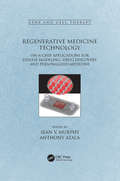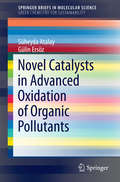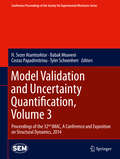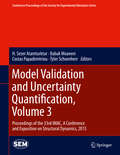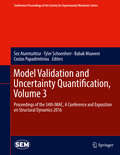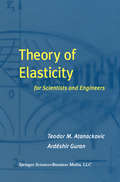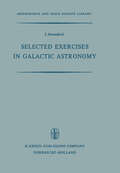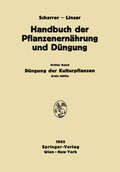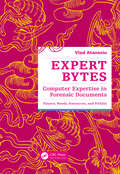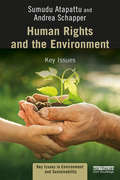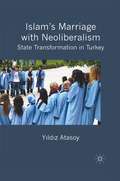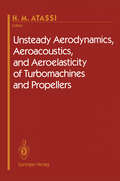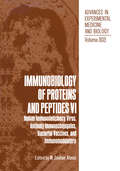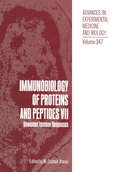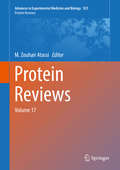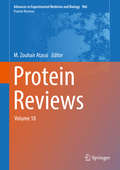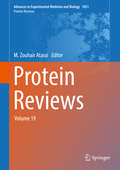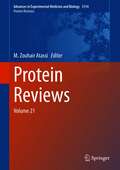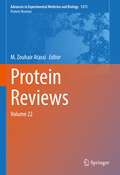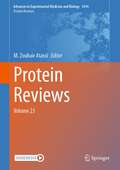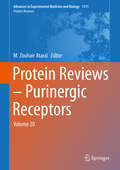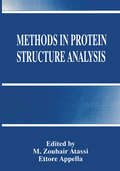- Table View
- List View
Regenerative Medicine Technology: On-a-Chip Applications for Disease Modeling, Drug Discovery and Personalized Medicine (Gene and Cell Therapy)
by Anthony Atala Sean V. MurphyMiniaturization in the fields of chemistry and molecular biology has resulted in the "lab-on-a-chip." Such systems are micro-fabricated devices capable of handling extremely small fluid volumes facilitating the scaling of single or multiple lab processes down to a microchip-sized format. The convergence of lab-on-a-chip technology with the field of cell biology facilitated the development of "organ-on-a-chip" systems. Such systems simulate the function of tissues and organs, having the potential to bypass some cell and animal testing methods. These technologies have generated high interest as applications for disease modeling and drug discovery. This book, edited by Drs. Sean Murphy and Anthony Atala, provides a comprehensive coverage of the technologies that have been used to develop organ-on-a-chip systems. Known leaders cover the basics to the most relevant and novel topics in the field, including micro-fabrication, 3D bio-printing, 3D cell culture techniques, biosensor design and microelectronics, micro-fluidics, data collection, and predictive analysis. The book describes specific tissue types amenable for disease modeling and drug discovery applications. Lung, liver, heart, skin and kidney "on-a-chip" technologies are included as well as a progress report on designing an entire "body-on-a-chip" system. Additionally, the book covers applications of various systems for modeling tissue-specific cancers, metastasis, and tumor microenvironments; and provides an overview of current and potential applications of these systems to disease modeling, toxicity testing, and individualized medicine.
Novel Catalysts in Advanced Oxidation of Organic Pollutants (SpringerBriefs in Molecular Science)
by Süheyda Atalay Gülin ErsözThis brief summarizes the role of certain catalysts and associated processes that are involved in the reduction or elimination of hazardous substances from wastewater and the exploitation of renewable raw materials. The authors begin by providing a summary of the most recent developments in catalysts used in the advanced oxidation of organic pollutants in aqueous phase. Advanced Oxidation Processes (AOPS) are described in terms of homogeneous and heterogeneous catalysts. Some emphasis is placed on the role nanocatalysts, perovskite-type catalysts, and green catalysts play in several AOPs such as Fenton Chemistry, photocatalytic oxidation, and the hybrid technologies that combine different processes. Catalyst preparation, characterization, reaction chemistry, and process technology are described. Specific wastewater case studies which illustrate the role of these catalysts in AOPs completes the brief.
Model Validation and Uncertainty Quantification, Volume 3: Proceedings of the 32nd IMAC, A Conference and Exposition on Structural Dynamics, 2014 (Conference Proceedings of the Society for Experimental Mechanics Series)
by H. Sezer Atamturktur Babak Moaveni Costas Papadimitriou Tyler SchoenherrThis third volume of eight from the IMAC - XXXII Conference, brings together contributions to this important area of research and engineering. The collection presents early findings and case studies on fundamental and applied aspects of Structural Dynamics, including papers on:Linear SystemsSubstructure ModellingAdaptive StructuresExperimental TechniquesAnalytical MethodsDamage DetectionDamping of Materials & MembersModal Parameter IdentificationModal Testing MethodsSystem IdentificationActive ControlModal Parameter EstimationProcessing Modal Data
Model Validation and Uncertainty Quantification, Volume 3: Proceedings of the 33rd IMAC, A Conference and Exposition on Structural Dynamics, 2015 (Conference Proceedings of the Society for Experimental Mechanics Series)
by H. Sezer Atamturktur Babak Moaveni Costas Papadimitriou Tyler SchoenherrModel Validation and Uncertainty Quantification, Volume 3. Proceedings of the 33rd IMAC, A Conference and Exposition on Balancing Simulation and Testing, 2015, the third volume of ten from the Conference brings together contributions to this important area of research and engineering. The collection presents early findings and case studies on fundamental and applied aspects of Structural Dynamics, including papers on:Uncertainty Quantification & Model ValidationUncertainty Propagation in Structural Dynamics Bayesian & Markov Chain Monte Carlo MethodsPractical Applications of MVUQAdvances in MVUQ & Model Updating
Model Validation and Uncertainty Quantification, Volume 3: Proceedings of the 34th IMAC, A Conference and Exposition on Structural Dynamics 2016 (Conference Proceedings of the Society for Experimental Mechanics Series)
by Sez Atamturktur Tyler Schoenherr Babak Moaveni Costas PapadimitriouModel Validation and Uncertainty Quantifi cation, Volume 3. Proceedings of the 34th IMAC, A Conference and Exposition on Dynamics of Multiphysical Systems: From Active Materials to Vibroacoustics, 2016, the third volume of ten from the Conference brings together contributions to this important area of research and engineering. Th e collection presents early findings and case studies on fundamental and applied aspects of Structural Dynamics, including papers on:• Uncertainty Quantifi cation & Model Validation• Uncertainty Propagation in Structural Dynamics• Bayesian & Markov Chain Monte Carlo Methods• Practical Applications of MVUQ• Advances in MVUQ & Model Updating• Robustness in Design & Validation• Verifi cation & Validation Methods
Theory of Elasticity for Scientists and Engineers
by Teodor M. Atanackovic Ardeshir GuranThis book is intended to be an introduction to elasticity theory. It is as sumed that the student, before reading this book, has had courses in me chanics (statics, dynamics) and strength of materials (mechanics of mate rials). It is written at a level for undergraduate and beginning graduate engineering students in mechanical, civil, or aerospace engineering. As a background in mathematics, readers are expected to have had courses in ad vanced calculus, linear algebra, and differential equations. Our experience in teaching elasticity theory to engineering students leads us to believe that the course must be problem-solving oriented. We believe that formulation and solution of the problems is at the heart of elasticity theory. 1 Of course orientation to problem-solving philosophy does not exclude the need to study fundamentals. By fundamentals we mean both mechanical concepts such as stress, deformation and strain, compatibility conditions, constitu tive relations, energy of deformation, and mathematical methods, such as partial differential equations, complex variable and variational methods, and numerical techniques. We are aware of many excellent books on elasticity, some of which are listed in the References. If we are to state what differentiates our book from other similar texts we could, besides the already stated problem-solving ori entation, list the following: study of deformations that are not necessarily small, selection of problems that we treat, and the use of Cartesian tensors only.
Selected Exercises in Galactic Astronomy (Astrophysics and Space Science Library #26)
by I. AtanasijevicGalactic Astronomy is, and for some time to come will certainly remain, one of the more important items in the astronomy curricula. There are at present a number of excellent text-books and monographs covering the whole subject or certain of its aspects. It seems however that there is not a single book where at least some of the more important problems dealt with in text-books and university courses would be presented in the form of laboratory exercises. This short series of exercises represents an attempt to fill this gap. What is, in general, the aim of such exercises? As to this point, the author fully agrees with Prof. Minnaert's opinion that "No natural science should ever be taught without practical work. Students in astronomy should have regular exercises, not so much to teach them observing skill, but mainly to bring before their eyes the reality of the concepts introduced during the lectures." This applies to Galactic Astronomy as well as to any other branch of our science.
Düngung der Kulturpflanzen: Erste Hälfte (Handbuch der Pflanzenernährung und Düngung #3 / 1)
by N. Atanasiu W. Baden F. Baltin L. D. Baver A. Blamauer E. v. Boguslawski K. Bräunlich D. Brüning Y. Coïc Diplomgärtnerin Liselotte Forchthammer W. Frohner A. Fruhstorfer L. Gisiger M. Gökgöl W. Gruppe C. Heinemann W. Jahn-Deesbach J. Jung E. Klapp L. M. Kopetz H. Kraut P. W. Kürten H. Linser H. Löcker H. Lüdecke Direktor F. Mappes A. v. Müller W. Müller K. Nehring K.-H. Neumann F. Penningsfeld Edith Primost H. Rüther K. Schmid H. Schröder W. Schuster O. Siegel O. Steineck R. Steiner V. Tay?i H. Will W. Wirths F. ZattlerSeit dem Erscheinen des zweibändigen Standardwerkes von F. HONCAMP, "Handbuch der Pflanzenernährung und Düngerlehre", sind mehr als dreißig Jahre vergangen. Bei den stürmischen Fortschritten auf allen Gebieten der Natur wissenschaften, insbesondere der Chemie, Pflanzenphysiologie, Biochemie, Bodenkunde und Technologie, ist dieses zur Zeit seines Erscheinens so aus gezeichnete Handbuch natürlich längst veraltet. Zweifellos besteht heute ein dringendes Bedürfnis nach einem ähnlichen Werk. Wenn wir von dem ursprünglichen Plan abgekommen sind, das HONCAMP sche Handbuch in neuer Auflage zu bearbeiten, so vor allem deswegen, weil die tiefgreifende Entwicklung auf diesem Gebiet eine völlig neue Gestaltung des Werkes geboten erscheinen ließ. Es gliedert sich nun in drei Bände. Band I behandelt im wesentlichen die physiologischen Grundlagen der Pflanzenernährung. Er enthält eine ausführliche und systematische Darstellung der eigentlichen Ernährungsphysiologie. Auf eine Erörterung der allgemeinen pflanzen physiologischen Grundlagen konnte dabei verzichtet werden, weil im RUHLAND sehen "Handbuch der Pflanzenphysiologie" ein umfassendes und modernes Nach schlagewerk zur Verfügung steht. Band II beschäftigt sich mit dem Boden und den Düngemitteln. Unter Berücksichtigung der modernen Agrikulturchemie haben wir das heutige Wissen über den Boden als Standort und Nährstoffquelle der Pflanze unter den Verhält nissen der landwirtschaftlichen Praxis und des Gartenbaues bzw. des Forstwesens systematisch zusammengefaßt. Die folgenden Kapitel befassen sich mit der Beschreibung und Herstellung der verschiedenen Wirtschafts- und Handels düngemittel. Gerade auf diesem Gebiet bestehen in der wissenschaftlichen Literatur erhebliche Lücken, da keine größeren Lehr-oder Handbücher vorhanden sind, die sich eingehender mit der Technologie der Düngemittel und der Düngung beschäftigen.
Düngung der Kulturpflanzen 2 (Handbuch der Pflanzenernährung und Düngung #3 / 2)
by Professor Dr. Atanasiu Professor Dr. Baden Professor Dr.-Ing. Baltin Dr. L. Baver Dipl.-Ing. A. Blamauer Professor Dr. Boguslawski Diplomlandwirt Dr. Bräunlich Diplomlandwirt Dr. Brüning Professeur Dr. Coïc Diplomgärtnerin Liselotte Forchthammer Ing. W. Frohner Professor Dr. Fruhstorfer Direktor Dr. Gisiger Dr. M. Gökgöl Professor Dr. Gruppe Dr. C. Heinemann Dozent Dr. Jahn-Deesbach Dr. J. Jung Professor Dr. Klapp Professor Dr. Kopetz Professor Dr. Kraut Dr. P. Kürten Professor Dr. Linser Dr.-Ing. H. Löcker Professor Dr. Lüdecke Direktor F. Mappes Dr. A. Müller Dr. W. Müller Professor Dr. Nehring Dr. K.-H. Neumann Dr. F. Penningsfeld Dozent Dipl.-Ing. Primost Professor Dr. Rüther Professor Dr. Schmid Dr. H. Schröder Priv.-Doz. Dr. Schuster Direktor Professor Siegel Professor Dipl.-Ing. Steineck Dipl.-Ing. R. Steiner Professor Dr. Tay?i Dr. Hannellore Will Priv.-Doz. Dr. Wirths Professor Dr. ZattlerExpert Bytes: Computer Expertise in Forensic Documents - Players, Needs, Resources and Pitfalls
by Vlad AtanasiuExpert Bytes: Computer Expertise in Forensic Documents Players, Needs, Resources and Pitfallsintroduces computer scientists and forensic document examiners to the computer expertise of forensic documents and assists them with the design of research projects in this interdisciplinary field. This is not a textbook on how to perform the actua
Human Rights and the Environment: Key Issues (Key Issues in Environment and Sustainability)
by Sumudu Atapattu Andrea SchapperThe field of human rights and the environment has grown phenomenally during the last few years and this textbook will be one of the first to encourage students to think critically about how many environmental issues lead to a violation of existing rights. Taking a socio-legal approach, this book will provide a good understanding of both human rights and environmental issues, as well as the limitations of each regime, and will explore the ways in which human rights law and institutions can be used to obtain relief for the victims of environmental degradation or of adverse effects of environmental policies. In addition, it will place an emphasis on climate change and climate policies to highlight the pros and cons of using a human rights framework and to underscore its importance in the context of climate change. As well as identifying emerging issues and areas for further research, each chapter will be rich in pedagogical features, including web links to further research and discussion questions for beyond the classroom. Combining their specialisms in law and politics, Atapattu and Schapper have developed a truly inter-disciplinary resource that will be essential for students of human rights, environmental studies, international law, international relations, politics, and philosophy.
Human Rights and the Environment: Key Issues (Key Issues in Environment and Sustainability)
by Sumudu Atapattu Andrea SchapperThe field of human rights and the environment has grown phenomenally during the last few years and this textbook will be one of the first to encourage students to think critically about how many environmental issues lead to a violation of existing rights. Taking a socio-legal approach, this book will provide a good understanding of both human rights and environmental issues, as well as the limitations of each regime, and will explore the ways in which human rights law and institutions can be used to obtain relief for the victims of environmental degradation or of adverse effects of environmental policies. In addition, it will place an emphasis on climate change and climate policies to highlight the pros and cons of using a human rights framework and to underscore its importance in the context of climate change. As well as identifying emerging issues and areas for further research, each chapter will be rich in pedagogical features, including web links to further research and discussion questions for beyond the classroom. Combining their specialisms in law and politics, Atapattu and Schapper have developed a truly inter-disciplinary resource that will be essential for students of human rights, environmental studies, international law, international relations, politics, and philosophy.
Islam’s Marriage with Neoliberalism: State Transformation in Turkey
by Y. AtasoyThe transformation of the Turkish state is examined here in the context of globalized frames of neo-liberal capitalism and contemporary schemas of Islamic politics. It shows how the historical emergence of two distinct yet intertwined imaginaries of state structuring, laiklik and Islam, continues to influence Turkish politics today.
Unsteady Aerodynamics, Aeroacoustics, and Aeroelasticity of Turbomachines and Propellers
by H. M. AtassiThe first International Symposium on Unsteady Aerodynamics and Aero elasticity of Turbomachines was held in Paris in 1976, and was followed by symposia at Lausanne in 1980, Cambridge in 1984, Aachen in 1987, Bei jing in 1989, and Notre Dame in 1991. The proceedings published following these symposia have become recognized both as basic reference texts in the subject area and as useful guides to progress in the field. It is hoped that this volume, which represents the proceedings of the Sixth International Symposium on Unsteady Aerodynamics of Turbomachines, will continue that tradition. Interest in the unsteady aerodynamics, aeroacoustics, and aeroelasticity of turbomachines has been growing rapidly since the Paris symposium. This expanded interest is reflected by a significant increase in the numbers of contributed papers and symposium participants. The timeliness of the topics has always been an essential objective of these symposia. Another important objective is to promote an international exchange between scien tists and engineers from universities, government agencies, and industry on the fascinating phenomena of unsteady turbomachine flows and how they affect the aeroelastic stability of the blading system and cause the radiation of unwanted noise. This exchange acts as a catalyst for the development of new analytical and numerical models along with carefully designed ex periments to help understand the behavior of such systems and to develop predictive tools for engineering applications.
Immunobiology of Proteins and Peptides-III: Viral and Bacterial Antigens (Advances in Experimental Medicine and Biology #185)
by M. Z. AtassiThis symposia series, founded in 1976, is devoted to the advancement and dissemination of knowledge in the field in immunology, particularly as it relates to the immune recognition and responses to protein and peptide antigens. Leading investigators are convened every 2 or 3 years for the purpose of consolidating the research on protein and peptide antigens of defined structure and to focus on these findings in the context of contemporary immunology. Each symposium has focussed on a particular aspect of molecular and cellular immunology of proteins and peptides. It is extremely gratifying that, in the last 2-3 years, the scientific community has shown a heightened interest in the study and understanding of protein and peptide antigens. The third symposium was devoted to viral and bacterial antigens. Great advances have been made in recent years in the elucidation and synthesis of protein antigenic sites. These, together with advances in cloning, expression and sequencing of protein genes, have offered new avenues for the preparation of synthetic vaccines for viral, bacterial and other antigens. Such vaccines have been the aspiration of immunologists for over 20 years. The meeting has served to integrate and correlate the current knowledge of these systems with developing trends in immunology and to identify the most promising new directions for future investigations.
Immunobiology of Proteins and Peptides VI: Human Immunodeficiency Virus, Antibody Immunoconjugates, Bacterial Vaccines, and Immunomodulators (Advances in Experimental Medicine and Biology #303)
by M. Zouhair AtassiThe articles in this volume represent papers delivered by invited speakers at the 6th International Symposium on the Immunobiology of Proteins and Peptides. In addition, a few of the abstracts submitted by participants were scheduled for minisymposia and some of the authors, whose presentations were judged by the Scientific Council to be of high quality, were invited to submit papers for publication in this volume. This symposium was established in 1976 for the purpose of bringing together, once every two or three years, active investigators in the forefront of contemporary immunology, to present their findings and discuss t heir significance in the light of current concepts and to identify important new directions of investigation. The founding of the symposium was stimulated by the achievement of major breakthroughs in the understanding of the immune recognition of proteins and peptides. We believed that these breakthroughs will lead to the creation of a new generation of peptide reagents which should have enormous potential in biological, therapeutic and basic applications. This anticipated explosion has in fact since occurred and many applications of these pep tides are now being realized.
Immunobiology of Proteins and Peptides VII: Unwanted Immune Responses (Advances in Experimental Medicine and Biology #347)
by M. Zouhair AtassiThe articles in this volume represent papers delivered by invited speakers at the 7th International Symposium on the Immunobiology of Proteins and Peptides. In addition, a few of the abstracts submitted by participants were scheduled for minisymposia and some of the authors, whose presentations were judged by the Scientific Council to be of high quality, were invited to submit papers for publication in this volume. This symposium was established in 1976 for the purpose of bringing together, once every two or three years, active investigators in the forefront of contemporary immunology, to present their findings and discuss their significance in the light of current concepts and to identify important new directions of investigation. The founding of the symposium was stimulated by the achievement of major breakthroughs in the understanding of the immune recognition of proteins and peptides. We believed that these breakthroughs will lead to the creation of a new generation of peptide reagents which should have enormous potential in biological, therapeutic, and basic applications. This anticipated explosion has in fact since occurred and many applications of these peptides are now being realized. The seventh symposium focused on immune responses that have undesirable effects on the host, hence we named them unwanted immune responses. Two major aspects of unwanted immune responses were discussed at the symposium: Allergy and Autoimmunity.
Protein Reviews: Volume 17 (Advances in Experimental Medicine and Biology #925)
by M. Zouhair AtassiThe aim of the Protein Reviews is to serve as a publication vehicle for review articles that focus on crucial current vigorous aspects of protein structure, function, evolution and genetics. Volume 17 of Protein Reviews is the beginning of a new publication format. The volumes will appear online before they are published in a printed book. Articles will be selected according to their importance to the understanding of biological systems, their relevance to the unravelling of issues associated with health and disease or their impact on scientific or technological advances and developments. The chapters in this volume are authored by experts in the field. They deal with aspects of structure and biological activity of selected proteins. Specific chapters deal with the aggregation of FET proteins (FUS, EWSR1, TAF15) as a pathological change in amyotrophic lateral sclerosis, structural changes fundamental to gating of the cystic fibrosis transmembrane conductance regulator anion channel pore, the dual roles for epithelial splicing regulatory proteins 1 (ESRP1) and 2 (ESRP2) in cancer progression, controlling autolysis during flagella insertion in Gram-negative bacteria, the regulation of skeletal muscle myoblast differentiation and the proliferation by pannexins, hyaluronidase and chondroitinase, factors that control mitotic spindle elongation, how secreted phospholipase A2 type IIA (sPLA2-IIA) activates integrins in an allosteric manner, the simple and unique allosteric machinery of Thermus caldophilus lactate dehydrogenase, and the reduction of chemically stable multibonds: Nitrogenase-like biosynthesis of tetrapyrroles. This volume is intended for research scientists, clinicians, physicians, and graduate students in fields of biochemistry, cell biology, molecular biology microbiology, immunology and genetics.
Protein Reviews: Volume 18 (Advances in Experimental Medicine and Biology #966)
by M. Zouhair AtassiThe aim of the Protein Reviews is to serve as a publication vehicle for review articles that focus on crucial current vigorous aspects of protein structure, function, evolution and genetics. The volumes will appear online before they are published in a printed book. Articles are selected according to their importance to the understanding of biological systems, their relevance to the unravelling of issues associated with health and disease or their impact on scientific or technological advances and developments. The chapters in volume 18 are authored by experts in the field. They deal with aspects of structure and/or biological activity of selected proteins. The chapters review current research of the following topics: the Mechanism of channel gating and regulation of the activity of calcium-activated chloride channel ANO1, Structure and function of the two-component cytotoxins of Staphylococcus aureus, Membrane Fusion and Infection involving the influenza virus hemagglutinin, The impact of arrhythmogenic mutations through the structural determination of the L-type voltage-gated calcium channel, Discussion of some open questions pertaining to histone post-translational modifications and nucleosome organization in transcriptional regulation, Regulation of the extracellular SERPINA5 (protein C inhibitor) penetration through cellular membranes, Coding of Class I and II aminoacyl-tRNA synthetases, Nephrin phosphorylation in diabetes and chronic kidney injury, The structure-forming juncture in oxidative protein folding and the events in the ER, The polyspecificity of anti-lipid antibodies and its relevance to the development of autoimmunity. This volume is intended for research scientists, clinicians, physicians and graduate students in the fields of biochemistry, cell biology, molecular biology, immunology and genetics.
Protein Reviews: Volume 19 (Advances in Experimental Medicine and Biology #1051)
by M. Zouhair AtassiThe aim of the Protein Reviews is to serve as a publication vehicle for review articles that focus on crucial current vigorous aspects of protein structure, function, evolution and genetics. The volumes will appear online before they are published in a printed book. Articles are selected according to their importance to the understanding of biological systems, their relevance to the unravelling of issues associated with health and disease or their impact on scientific or technological advances and developments. Volume 19 focusses on Purinergic receptors, also termed purinoceptors. These are plasma membrane proteins present in nearly all mammalian tissues. They participate in a number of cell functions that include proliferation and migration of neural stem cells, vascular reactivity, apoptosis and cytokine secretion and have been associated with learning and memory, feeding conduct, movement and sleep. They facilitate relaxation of smooth muscle of the gut in response to adenosine (P1 receptors) or ATP (P2 receptors). The chapters in this volume are authored by experts in the field. They deal with aspects of structure and biological activity of selected receptor proteins. The first chapter in this volume reviews the current research on the Mechanism of channel gating and regulation of the activity of calcium-activated chloride channel ANO1. This is followed by a chapter dealing with Structure and function of the two-component cytotoxins of Staphylococcus aureus and a chapter on Membrane Fusion and Infection involving the Influenza virus Hemagglutinin. The fourth chapter reviews the impact of arrhythmogenic mutations through the structural determination of the L-type voltage-gated calcium channel. Then there is a chapter that discusses some open questions pertaining to histone post-translational modifications and nucleosome organization in transcriptional regulation. The next chapter deals with regulation of the extracellular SERPINA5 (protein C inhibitor) penetration through cellular membranes. This is followed by a chapter on coding of Class I and II aminoacyl-tRNA synthetases; a chapter on regulation of nephrin phosphorylation in diabetes and chronic kidney injury and a chapter on The Structure-Forming Juncture in oxidative protein folding and the events in the ER. Finally the last chapter deals with the polyspecificity of anti-lipid antibodies and its relevance to the development of autoimmunity. This volume is intended for research scientists, clinicians, physicians and graduate students in the fields of biochemistry, cell biology, molecular biology, immunology and genetics.
Protein Reviews: Volume 21 (Advances in Experimental Medicine and Biology #21)
by M. Zouhair AtassiThe Protein Reviews series serves as a publication vehicle for reviews that focus on crucial contemporary and vital aspects of protein structure, function, evolution and genetics. Volumes are published online first, prior to publication in a printed book. Chapters are selected according to their importance to the understanding of biological systems, relevance to the unravelling of issues associated with health and disease, or impact on scientific or technological advances and developments. Volume 21 presents eight review chapters authored by experts in the related fields. The first chapter covers the enzyme squalene monooxygenase and lipid levels and its relevance in health and disease. Chapter two presents a systematic analysis of the structural and functional aspects of heteromeric solute carriers. The third chapter provides a review of the role of CI- in type IV collagen assembly, function, and disease, including future directions for studies. This is followed by a summary in chapter four about the recent progress on defining the roles of the Slit-Robo signaling in bone metabolism and the possible roles of the interaction between Robo and neural epidermal growth factor-like proteins. Chapter five discusses recent data about the evolutionary aspects on structural differences between humans and the nematode in relation to previous knowledge of core proteins and GAG-attachment sites in Chn and CS proteoglycans of C.elegans and humans. The sixth chapter summarizes the immunochemical character of the IGHV1-69-derived RFs and the recognition mechanism of the IGHV1-69-derived RFs. Chapter seven covers regulated alternative translocation and its role as an emerging mechanism to regulate transmembrane proteins. Finally, chapter eight reviews current progress on IL-36 protein and biology and novel investigative tools. This volume is intended for research scientists, clinicians, physicians and graduate students in the fields of biochemistry, cell biology, molecular biology, immunology and genetics.
Protein Reviews: Volume 22 (Advances in Experimental Medicine and Biology #1371)
by M. Zouhair AtassiThe Protein Reviews series serves as a publication vehicle for reviews that focus on crucial contemporary and vital aspects of protein structure, function, evolution and genetics. Volumes are published online first, prior to publication in a printed book. Chapters are selected according to their importance to the understanding of biological systems, relevance to the unravelling of issues associated with health and disease, or impact on scientific or technological advances and developments. Volume 22 presents six review chapters authored by experts in related fields. The first chapter covers carotenoid-protein interactions. Chapter two addresses the non-continuum of eukaryotic transcriptional regulation. The third chapter reviews the structure of the regulatory and catalytic domains of the photoreceptor phosphodiesterase (PDE6) holoenzyme. Chapter four reviews the current knowledge on small molecule compounds that have been evaluated as rhodopsin modulators to be considered as leads for the development of novel therapies for retinitis pigmentosa. Chapter five deals with Plasticity-associated functionality and inhibition of the HIV protease. Finally, chapter six covers single-run catalysis and kinetic control of human telomerase holoenzyme. This volume is intended for research scientists, clinicians, physicians and graduate students in the fields of biochemistry, cell biology, molecular biology, immunology and genetics.
Protein Reviews: Volume 23 (Advances in Experimental Medicine and Biology #1414)
by M. Zouhair AtassiThe Protein Reviews series serves as a publication vehicle for reviews that focus on crucial contemporary and vital aspects of protein structure, function, evolution and genetics. Volumes are published online first, prior to publication in a printed book. Chapters are selected according to their importance to the understanding of biological systems, relevance to the unravelling of issues associated with health and disease, or impact on scientific or technological advances and developments. Volume 23 presents four review chapters authored by experts in related fields. The first chapter covers the structure and function of SNM1 family nucleases. Chapter two examines the molecular details of DNA integration by CRISPR-associated (Cas) proteins during adaptation in bacteria and archaea. The third chapter reviews the ordered motions in the nitric-oxide dioxygenase (NOD) mechanism of flavohemoglobin and assorted globins with tightly coupled reductases. Chapter four reviews structural analyses of the multicopper site of CopG support a role as a redox enzyme. This volume is intended for research scientists, clinicians, physicians and graduate students in the fields of biochemistry, cell biology, molecular biology, immunology and genetics.
Protein Reviews – Purinergic Receptors: Volume 20 (Advances in Experimental Medicine and Biology #1111)
by M. Zouhair AtassiThe Protein Reviews series serves as a publication vehicle for reviews that focus on crucial contemporary and vital aspects of protein structure, function, evolution and genetics. Volume 20, Purinergic Receptors, has ten chapters. The first five chapters deal with various aspects of membrane binding. The first chapter focuses on the phox-homology (PX) domain, which is a phosphoinositide-binding domain conserved in all eukaryotes and present in forty-nine human proteins. The next chapter deals with the modeling of PH domains/phosphoinositides interactions. This is followed by a chapter on BAR domain proteins regulate Rho GTPase signaling. The BAR (Bin–Amphiphysin–Rvs) domain is a membrane lipid binding domain present in a wide variety of proteins, often proteins with a role in Rho-regulated signaling pathways. The fourth article presents AP180 N-terminal homology (ANTH) and Epsin N-terminal homology (ENTH) domains and discusses their physiological functions and involvement in disease. The fifth article reviews the polyphosphoinositide-binding domains and presents insights from peripheral membrane and lipid-transfer proteins. This is followed by a chapter on the physiological functions of phosphoinositide-modifying enzymes and their interacting proteins in Arabidopsis, then by a chapter on the molecular mechanisms of Vaspin action in various tissues such as adipose tissue, skin, bone, blood vessels, and the brain. The eighth chapter deals with exceptionally selective substrate targeting by the metalloprotease anthrax lethal factor followed by an article on Salmonella, E. coli, and Citrobacter type III secretion system effector proteins that alter host innate immunity. The last chapter presents New techniques to study intracellular receptors in living cells, with insights into RIG-I-like receptor signaling. Volume 20 is intended for research scientists, clinicians, physicians and graduate students in the fields of biochemistry, cell biology, molecular biology, immunology and genetics.
Methods in Protein Structure Analysis
by M. Zouhair Atassi Ettore AppellaThe MPSA international conference is held in a different country every two years. It is devoted to methods of determining protein structure with emphasis on chemistry and sequence analysis. Until the ninth conference, MPSA was an acronym for Methods in Protein Sequence Analysis. To give the conference more flexibility and breadth, the Scientific Advisory Committee of the lOth MPSA decided to change the name to Methods in Protein Structure Analysis; however, the emphasis remains on "methods" and on "chemistry. " In fact, this is the only major conference that is devoted to methods. The MPSA conference is truly international, a fact clearly reflected by the composi tion of its Scientific Advisory Committee. The Scientific Advisory Committee oversees the scientific direction of the MPSA and elects the chairman of the conference. Members of the committee are elected by active members, based on scientific standing and activity. The chairman, subject to approval of the Scientific Advisory Committee, appoints the Organizing Committee. It is this latter committee that puts the conference together. The lectures of the MPSA have traditionally been published in a special proceedings issue. This is different from, and more detailed than, the special MPSA issue of the Journal of Protein Chemistry in which only a brief description of the talks is given in short papers and abstracts. In the I Oth MPSA, about half the talks are by invited speakers and the remainder were selected from submitted short papers and abstracts.
